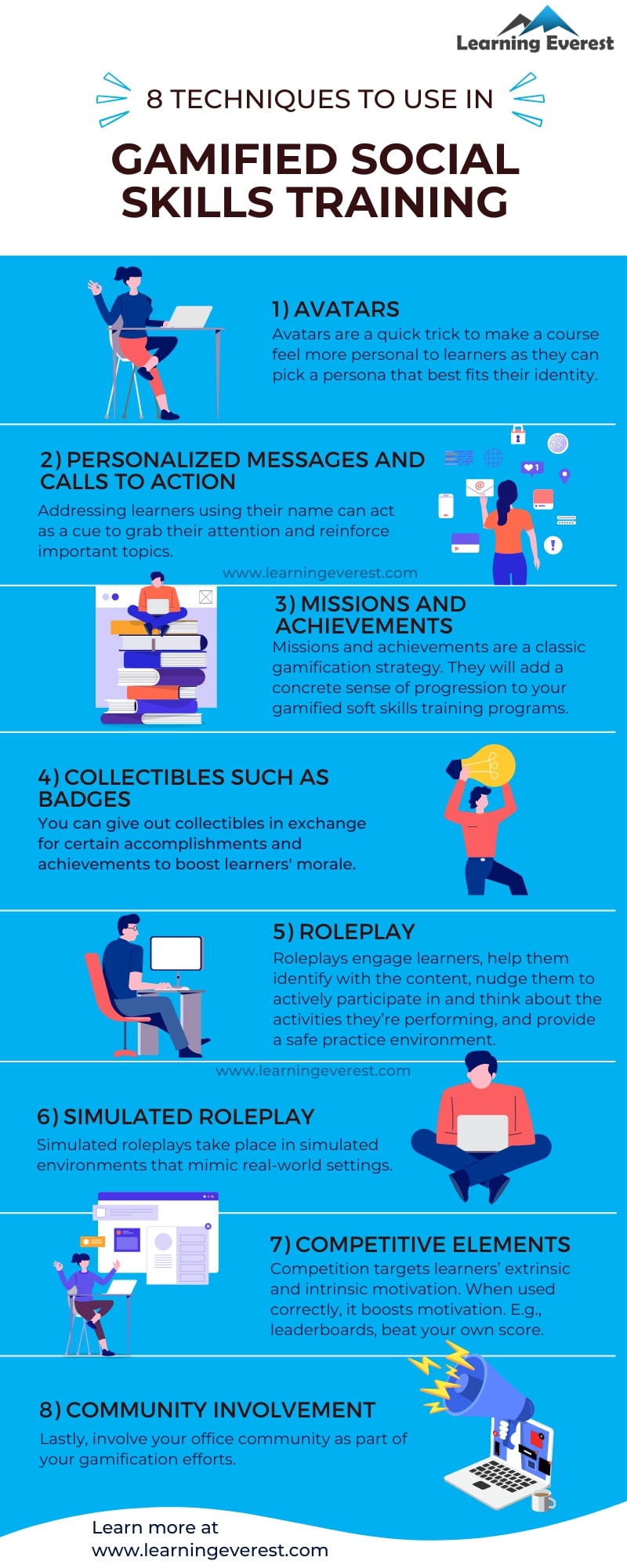Gamified soft skills training is an excellent solution to the challenge of developing soft skills in your workforce. While the quality of training materials does matter, getting learners to actually incorporate the soft skills they learn takes practice and self-reflection. Gamification provides a stimulating environment for this, ensuring that your training efforts yield a meaningful ROI. In this article, you will find 8 gamification techniques you can use to make your corporate soft skills training programs engaging and effective.
Here are the 8 Techniques to Use in Gamified Soft Skills Training
Use Avatars for Quick and Effective Personalization
An avatar is an image that expresses the user’s persona within a given activity. Avatars are a quick trick to make a course feel more personal to learners as they can pick a persona that best fits their identity. There are various ways to include avatars in gamified soft skills training:
- Give learners the option to pick from a pre-existing cast of characters
- Add the option for learners to add their own picture or sync their company or LMS profile to the program
Personalize Messages and Calls to Action
Use the learner’s name when addressing them in start and end screens, instructions, and dialogues. Doing so grabs their attention and acts as a cue to focus on the course’s contents. Addressing learners directly can also be used to reinforce important topics.
To further gamify messages and instructions, you can use a mascot. This mascot could be a personification of your company’s logo, a character that represents your company, or even founders/notable executives.
Assign Missions and Achievements
Missions and achievements are a classic gamification strategy. They will add a concrete sense of progression to your gamified soft skills training programs.
More importantly, achievements and missions highlight the most important parts of training to learners. They can be used to draw attention to concepts, reinforce topics, facilitate recall, and assess learning. They are also a more interesting alternative to points or grading systems.
Badges and Other Collectibles
You can also give out badges or other collectibles such as medals, tickets, mystery boxes, etc. Usually, such an element is given in exchange for achievements and other accomplishments such as gaining a certain score on quizzes, completing a certain number of modules, etc.
Collectibles greatly boost learners’ morale in gamified soft skills training and are also a highly effective source of extrinsic motivation.
Roleplay
Roleplays engage learners and help them identify with the content. They also nudge learners to actively participate in and think about the activities they’re performing. Furthermore, roleplay-based activities create opportunities for practicing soft skills in a safe environment with lower stakes which in turn builds learners’ confidence.
There are many ways to incorporate roleplay into your gamified soft skills training programs:
- Learners can interact with characters in the course through dialogues with options
- Through branching exercises, learners can find out about the outcomes of specific behaviors and receive feedback
- If there are time and budget constraints, you can opt for a less interactive approach where there are fewer actions required from the learner, but all personalized messages and instructions reinforce the role the learners are supposed to play so they remain in that headspace
Simulated Roleplay
Simulated roleplays are a more hands-on method. Here, learners have to explore and complete actions in an environment that mimics or has the same features as the real-world settings they will use specific soft skills in.
Simulations can be done via animated 2D environments or use pictures of the real workplace. AR/VR technology can also be used to make gamified soft skills training more immersive.
Incorporate Competitive Elements
The competition targets learners’ extrinsic and intrinsic motivation. When used correctly, it boosts motivation. However, if used incorrectly, it can easily backfire and demotivate your learners. Thus, this particular strategy should be used after carefully assessing your learner base.
Some common competitive elements found in gamified e-learning are:
- Leaderboards
- Beat your own score
- Exclusive titles for certain achievements
- Badges, medals, and trophies
However, you can also add more tangible real-world rewards such as vouchers, gift cards, nameplates, etc.
Community Involvement
Lastly, involve your office community as part of your gamification efforts. Here, the above-mentioned elements, especially collectibles, leaderboards, and personalization based on learner profiles can come in handy.
Learners can share their achievements with the community, have discussions, and exchange insights with each other. Additionally, creating conversation around new training programs will motivate learners who have a lower interest in participating.
Infographic
Conclusion
Gamified soft skills training is an effective, interactive, and engaging way to build soft skills in a workforce while keeping learner motivation and morale high at the same time.
Knowledge Check!
Frequently Asked Questions (FAQs)
How do you gamify soft skills training?
Soft skills training can be gamified using the following techniques:
- Avatars
- Personalized messages
- Missions and achievements
- Badges and collectibles
- Roleplay
- Simulated roleplay
- Competition like leaderboards and beating your personal record
- Community involvement
Why do you need gamified soft skills training?
Gamified soft skills training is an excellent solution to the challenge of developing soft skills in your workforce. While the quality of training materials does matter, getting learners to actually incorporate the soft skills they learn takes practice and self-reflection. Gamification provides a stimulating environment for this, ensuring that your training efforts yield a meaningful ROI.






